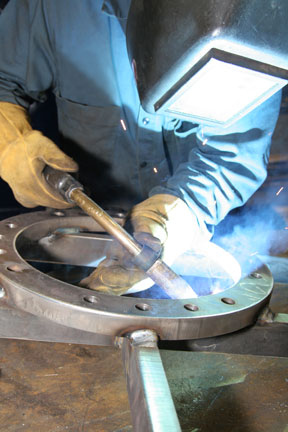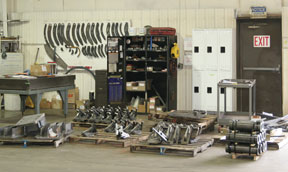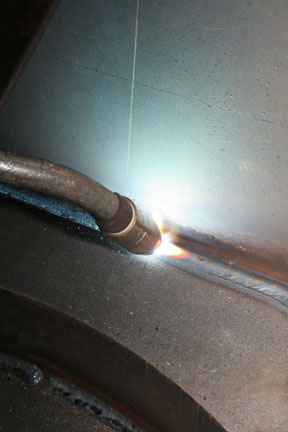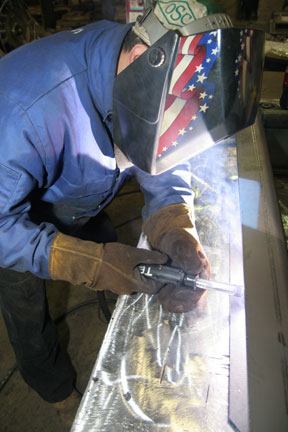Profiting In Lean Times
Bernard Consumables and MIG Guns Help OEM Fabricators Standardize Their Operations

Anyone in a job shop environment knows how much downtime accrues from changing over a welding cell to accommodate different product runs. For Wisconsin-based OEM Fabricators, that downtime added up to $2,000 a day until it adopted the “rule of ones,” which standardized their welding processes, and implemented lean manufacturing concepts back in 2004.
OEM is a job shop that specializes in fabricating components and assemblies for over 80 heavy equipment manufacturers across 20 industries, primarily the oil patch, oil exploration, power generation, and crane industries.
Serving that many customers and meeting product runs from 1 to 250 units per run, welding operators at OEM had to regularly change welding processes, change wires, change gases and change other variables to accommodate each new product runs.
The inefficiencies created by these changeovers, however, didn’t mesh well with the company’s philosophy.
“Our goal is to be an extension of our customers,” explains Manufacturing Engineer Scott Exner. “We provide the services and products that they choose not to manufacture internally, so they need to be able to come to us and receive a quality product, on time, at a fair price.”
That’s why the company adopted a “rule of ones” welding system — one process, one gas, one wire, one gun — as part of its implementation of lean manufacturing.
With Bernard Q-Gun™ MIG guns and Centerfire™ consumables as an integral part of that implementation, OEM was able to reduce their downtime and expand their welding operation two to three times its size since implementing the welding process standardization approximately three years ago. OEM significantly reduced the potential for quality variance between welding operators and greatly reduced the time it took to do initial hiring training for it welders.
A Pro-Active Approach
OEM was not experiencing a manufacturing crisis when it began implementing lean manufacturing principles in 2004, but as a continuously forward-looking company, they saw the potential offered by becoming lean.
“Integrating lean concepts in our operation has allowed us to look at all of our processes and how they’re interrelated,” Exner explains. “We might have as many as 20 people touching a product as it moves through the fabrication process. Lean principles help us provide our employees with the best information and the best tools to do their jobs as effectively as possible.”
Providing their customers with a consistent and high quality product has been one of the foundations upon which OEM has built its reputation. One of the toughest parts of upholding that reputation has been establishing uniformity and consistency between their 115 welding operators while also reducing downtime and rework.
Although it took only about 15 minutes for operators to change over from welding one product to another, the frequency of changeovers combined with the number of welding stations in the plant added up to a significant amount of time.
“When you make that changeover in a multi-process mode,” explains Exner, “you have to change to a different wire, different gas, and then go through and re-setup your process parameters. All of that takes time and creates the possibility for inconsistency.”

That’s when they began investigating the potential to standardize all of their welding operations on a single process, wire, gas, gun and consumables. The manufacturing flow and improvements and the savings that resulted are part of the reason OEM has been able to dramatically increase its size in a short period of time with two plants in full operation.
For their process, OEM selected an advanced pulsed MIG process from Miller Electric Mfg. Co. that is able to monitor the arc and adapt the current thousands of times per second, allowing OEM’s welders to simply pull the trigger and weld while the power source ensures the correct output is produced.
For the wire and gas, OEM selected a .045 ER70S-6 solid wire with a 90/10 Argon/CO2 mixed gas. The high argon content helps produce a very stable arc and allows the system to produce a spray transfer for high deposition and a calm weld puddle.
When it came to selecting the one gun and consumables package that would handle nearly all of their manufacturing needs, OEM chose Bernard Q-Guns with Centerfire consumables.

“When we first started integrating lean principles and standardization into our welding operations, guns and consumables were right at the top of our list,” Exner said. “We looked at a lot of different packages, but so far nothing has matched the Bernard Q300 gun and Centerfire consumables.”
In fact, Exner said he still reviews competitive guns and consumables on a yearly basis, and he has yet to find a product that provides a better result for their applications.
“We brought in guns from other manufacturers and sat down and wrote out a comparison listing what we liked and disliked about each gun,” Exner said. “There were some things we liked better on the other guns, but in the end, the Bernard Q300 was the whole package.”
One of the biggest benefits Exner saw in the Q-Gun was its ability to be custom configured to meet the needs of a variety of different applications within their shop. Bernard’s 24-hour online Configurator allows customers to build a customized MIG gun by individually selecting each component, from the contact tip to the power pin, based on their specific needs. The Configurator can then be used to request a price quote from the company’s nearest welding distributor.
“You can have different neck lengths, different bends and other options that allow it to fit into almost any position we need it to get into,” Exner said, noting that his operators especially like the rotatable neck, which allows them to access hard-to-reach joints and still be comfortable.
Overcoming operator resistance to change is a constant concern in any manufacturing environment, particularly with regard to equipment that alters the ergonomic environment, such as a welding gun. However, the operators at OEM were surprisingly accepting of the Q-Gun.
“I think I was more reluctant moving to the Q-Gun and Centerfire system than my welders were,” Exner said. “My guys loved the curved handles, the weight of the guns and the different neck configurations, so it was an easy choice for the people using the product to make the choice to go with Bernard.”
Implementing lean practices resulted in more arc-on time for their operators, but because they were running their guns as high as 260 to 270 amps, Exner became concerned that they would exceed the duty cycle. To date, they have found that the Q300 has been able to handle all of their welding needs while still providing a comfortable weight and maneuverable size that they couldn’t find in a 400-amp gun.
Another major factor in OEM’s decision to use Bernard MIG products was the Centerfire consumable system.
“We don’t look at consumables as a big item in terms of cost,” Exner explained. “We look at consumables from a standardization stand point. We’re willing to pay a little more up front for the consumables if they are going to result in improved standardization, increased throughput, and reduced re-work on the back end, and that’s what Centerfire provides.”
Featuring a fixed-recess, “drop-in” contact tip that sits in the diffuser and is held into place by a spatter guard in the nozzle, the Centerfire system provides OEM with consistent results regardless of who is behind the gun and a very calm gas flow that improves weld quality.
Helping to establish uniformity between operators, the Centerfire’s fixed recess contact tip prevents the current and heat variances that occur when operators adjust their contact tips to different depths.
“One of the biggest errors that welders tend to make is in setting the tip recess,” Exner said. “That plays a big role in how your arc is going to perform. Two different guys with the same tip recess are going to get more similar results than one guy using different tip recesses.’
Exner was also impressed by the gas flow provided by the built-in spatter guard.

“One of the biggest benefits to the Centerfire system has been the gas flow,” Exner said. “The spatter guard provides a smooth, gentle flow from the nozzle, which does a better job of keeping out the air atmosphere. Other consumables create a turbulent gas flow that mixes with the atmosphere because it comes out of the nozzle so fast and uncontrolled.”
Standardizing on one brand of consumables has also improved OEM’s inventory management system, which in turn reduces downtime and keeps their welders more productive.
“Labor is one of a company’s biggest costs, so we try to eliminate non-value-added time as much as possible,” Exner explained. “Standardizing on one brand of consumables means that if one operator runs out of tips, he can borrow one from his neighbor, rather than spending time going to the crib trying to track down a tip of the same make and model as the one he is using.”
Although OEM still has a few customers who require a departure from the one process, one gas, one wire, one gun practice, the vast majority of their customers have been thrilled with the results of their “rule of ones” philosophy – both in terms of the cost and quality of OEM’s product.
“At a time when most of our suppliers are increasing their prices, our customers are asking for price breaks,” Exner explained. “Our investment in implementing lean manufacturing principles into our welding operations has allowed us to provide our customers with not only better prices, but also a better product.”
Best of all, it has positioned OEM to continue their tremendous growth without worrying about incorporating new product runs into their existing operations.


